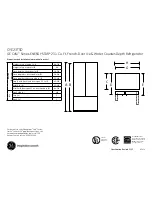
8
Defrosting the Refrigerator
To defrost the refrigerator, simply turn the thermostat to the ‘‘0’’ position and remove the
power plug from the power outlet. Place the drip tray under the evaporator to collect the
water. Remove the food and leave the door open.
When the ice has melted, wipe the interior with a soft cloth, reset the thermostat to 5, turn
the unit on and replace the food. When the unit has reached the desired temperature,
reduce the thermostat setting as required.
Switching off the appliance
To switch off the appliance, turn the temperature regulator to position ‘‘0’’. If the appliance is
not going to be used for an extended period:
- Remove all refrigerated package
- Switch the appliance by turning the temperature regulator to position ‘‘0’’
- Remove the mains plug or switch off or disconnect the electricity supply.
- Clean thoroughly (see cleaning and care)
- Leave the door open to avoid the build up of odours.
- Once the unit has been turned off, allow the unit to settle down for about 10 minutes
before turning the unit on. This will prevent the compressor from being damaged.
Energy Saving Hints
- Do not install the appliance close to sources of heat, such as a cooker, dishwasher
or radiator.
- Locate the appliance in a cool and well ventilated room and make sure that the air
openings of the cabinet are not obstructed.
- Avoid unnecessary frosting in the cabinet by packing all foodstuffs into airtight packages
before placing them in the refrigerator.
- Always leave warm food to cool down to room temperature before placing it in
the refrigerator.
- Try to avoid keeping the door open for long periods, or opening the door too frequently as
warm air will enter the cabinet, as this will lower efficiency of the refrigerator and minimise
the work of the compressor.
- Ensure there are no obstructions preventing the door from closing properly.
Summary of Contents for GVABF42
Page 1: ...Instruction Manual 42L Bar Fridge GVABF42 ...
Page 12: ......






























